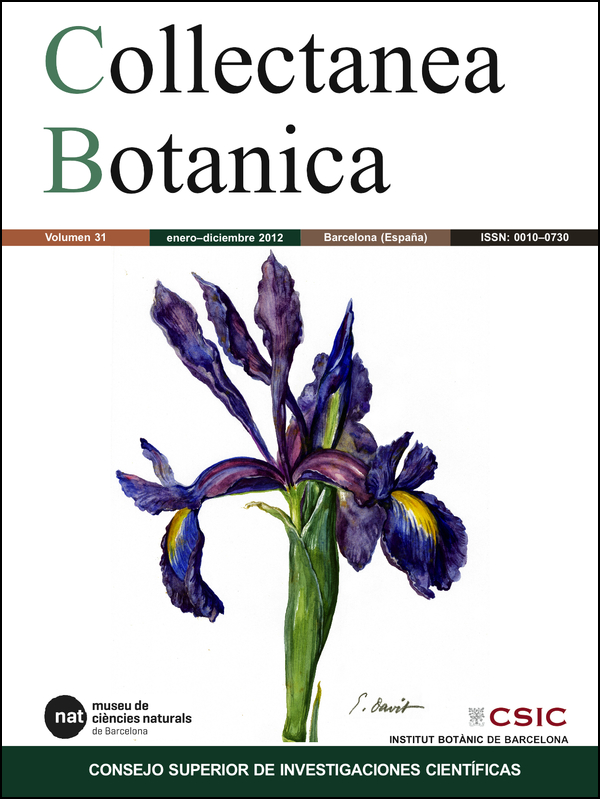Cycad diversification and tropical biodiversity
DOI:
https://doi.org/10.3989/collectbot.2012.v31.008Keywords:
climatic change, Cycadales, latitudinal diversity gradients, paleobiogeography, speciation timingAbstract
The recent unexpected discovery that living Cycadales are not Jurassic-Cretaceous (200– 65 Mya) relicts, as all their extant genera began to diversify during the Late Miocene (12 Mya), has challenged a classical evolutionary myth. This brief note shows how this finding may also provide new clues on the shaping of the high tropical biodiversity
Downloads
References
Hoorn, C., Wesselingh, F. P., ter Steege, H. et al. 2010. Amazonia through time: Andean uplift, climate change, landscape evolution, and biodiversity. Science 330: 927-931. http://dx.doi.org/10.1126/science.1194585 PMid:21071659
Hoorn, C., Wesselingh, F. P., Ter Steege, H. et al. 2011. Origins of Biodiversity–Response. Science 331: 399-400. http://dx.doi.org/10.1126/science.331.6016.399
Janssens, S. B., Knox, E. B., Huysmans, S., Smets, E. F. & Merckx, V. S. F. T. 2009. Rapid radiation of Impatiens (Balsaminaceae) during Pliocene and Pleistocene: Result of a global climate change. Mol. Phylogenet. Evol. 52: 806-824. http://dx.doi.org/10.1016/j.ympev.2009.04.013 PMid:19398024
MacColl, A. D. C. 2011. The ecological causes of evolution. Trends Ecol. Evol. 26: 514-522. http://dx.doi.org/10.1016/j.tree.2011.06.009 PMid:21763030
Mittelbach, G. G., Schemske, D. W., Cornell, H. V. et al. 2007. Evolution and the latitudinal diversity gradient, speciation, extinction and biogeography. Ecol. Lett. 4: 315-331. http://dx.doi.org/10.1111/j.1461-0248.2007.01020.x PMid:17355570
Mullen, S. P., Savage, W. K., Wahlberg, N. & Willmott, K. R. 2011. Rapid diversification and not clade age explains high diversity in neotropical Adelpha butterflies. Proc. R. Soc. B 278: 1777-1785. http://dx.doi.org/10.1098/rspb.2010.2140 PMid:21106589 PMCid:3097834
Nagalingum, N. S., Marshall, C. R., Quental, T. B., Rai, H. S., Little, D. P. & Mathews, S. 2011. Recent synchronous radiation of a living fossil. Science 334: 796-799. http://dx.doi.org/10.1126/science.1209926 PMid:22021670
Renner, S. S. 2011. Living fossil younger than thought. Science 334: 766-767. http://dx.doi.org/10.1126/science.1214649 PMid:22076366
Rull, V. 2008. Speciation timing and neotropical biodiversity, the Tertiary-Quaternary debate in the light of molecular phylogenetic evidence. Mol. Ecol. 17: 2722-2729. http://dx.doi.org/10.1111/j.1365-294X.2008.03789.x PMid:18494610
Rull, V. 2011a. Origins of biodiversity. Science 331: 398-299. http://dx.doi.org/10.1126/science.331.6016.398-c PMid:21273468
Rull, V. 2011b. Neotropical biodiversity: timing and potential drivers. Trends Ecol. Evol. 26: 508-513. http://dx.doi.org/10.1016/j.tree.2011.05.011 PMid:21703715
Rull, V. 2012. Palaeobiodiversity and taxonomic resolution: linking past trends with present patterns. J. Biogeogr. 39: 1005-1006. http://dx.doi.org/10.1111/j.1365-2699.2012.02735.x
Valente, L. M., Savolainen, V. & Vargas, P. 2010. Unparalleled rates of species diversification in Europe. Proc. R. Soc. B 277: 1489-1496. http://dx.doi.org/10.1098/rspb.2009.2163 PMid:20106850 PMCid:2871840
Weir, J. T. & Schluter, D. 2007. The latitudinal gradient in recent speciation and extinction rates of birds and mammals. Science 315: 1574-1576. http://dx.doi.org/10.1126/science.1135590 PMid:17363673
Wesselingh, F. P., Hoorn, C., Kroonenberg, S. B., Antonelli, A., Lundberg, J. G., Vonhof, H. B. & Hooghiemstra, H. 2010. On the origin of Amazonian landscapes and biodiversity, a synthesis. In: Hoorn, C. & Wesselingh, F. (Eds.), Amazonia, landscape and species evolution. Wiley-Blackwell, Oxford: 421-431.
Downloads
Published
How to Cite
Issue
Section
License
Copyright (c) 2012 Consejo Superior de Investigaciones Científicas (CSIC)

This work is licensed under a Creative Commons Attribution 4.0 International License.
© CSIC. Manuscripts published in both the print and online versions of this journal are the property of the Consejo Superior de Investigaciones Científicas, and quoting this source is a requirement for any partial or full reproduction.
All contents of this electronic edition, except where otherwise noted, are distributed under a Creative Commons Attribution 4.0 International (CC BY 4.0) licence. You may read the basic information and the legal text of the licence. The indication of the CC BY 4.0 licence must be expressly stated in this way when necessary.
Self-archiving in repositories, personal webpages or similar, of any version other than the final version of the work produced by the publisher, is not allowed.














